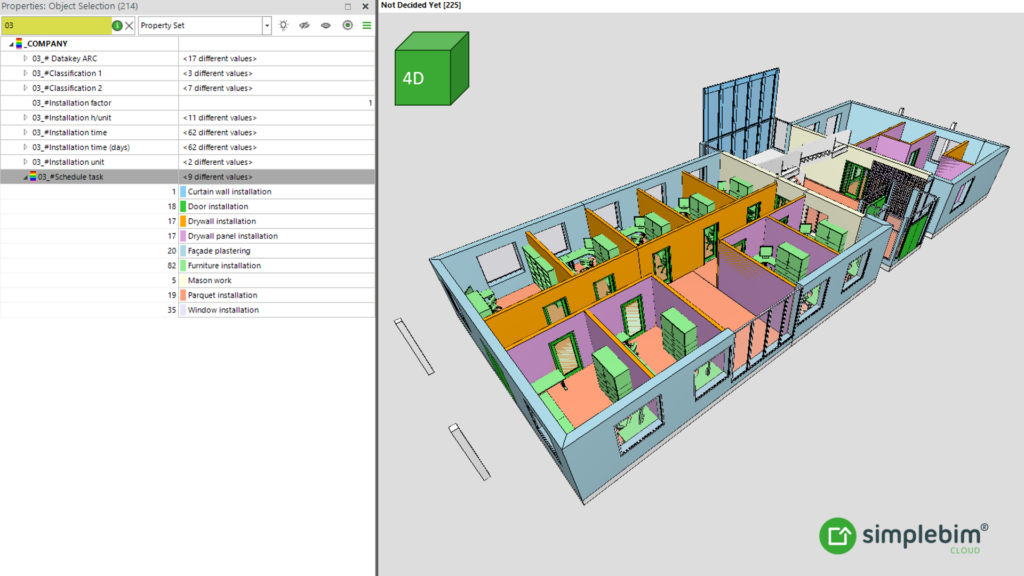Head of BIM Services Maria Lennox introduces Simplebim Cloud
24.11.2023
A qualified architect and BIM pioneer, before joining Simplebim early last year, Maria Lennox had been using her considerable skills to create BIM-related workflows in some of the largest construction companies (NCC and SRV) in the Nordics.
Committed to using Simplebim to help customers make BIM-data driven decisions by making it as easy as possible for them to use IFC data, she has been working on Simplebim Cloud, an automated data-wrangling tool.
Simplebim Cloud is already available to Finnish customers and soon-to-be available more widely, so we spoke to Head of BIM Services, Maria, about the product and how it’s taking the accessibility of BIM data to the next level.
What problems were you aiming to solve with Simplebim Cloud?
To explain this, we need to look at the designers, architects and engineers, the people who actually make the models. They make a model for their customers, fulfilling their specific data requirements, export the IFC and everything is fine, right?
But the problem is, as we all know, there are multiple different use cases for the models in construction projects, each with its own set of requirements. So, the person making the model needs to adapt their way of working to fulfill these requirements and that can be hard, and sometimes even impossible.

On the opposite side are the people who are using the models and the data inside the IFCs. Getting one IFC from one person, from one company, is manageable but in reality, you’ll get multiple IFCs from multiple disciplines, created by different companies, using different tools and different ways of exporting the IFCs.
It requires a lot of expert skill to be able to figure out how to use the models and where to find the required information. It’s this complexity we’re aiming to simplify with Simplebim Cloud.
What does it do?
Simplebim Cloud automatically wrangles the IFC data.
We use the Simplebim engine to standardise and enrich the data in the IFCs and the cloud to automate the process. So, the designers, engineers and architects we mentioned earlier, can simply deliver the basic IFC, they don’t need to change their way of working or code their software to deliver specific requirements, they can just focus on their design work, then upload it to the cloud.

Once the IFCs have been standardised and enriched in the cloud, the client doesn’t need to spend time trying to work out how to use the IFC or where to find the data, it is all there automatically, allowing them to focus on using the data to make good, informed decisions.
Even more compelling is the scalability of Simplebim Cloud. So far, we’ve talked about the complexity of working with multiple IFCs, from multiple disciplines, created using different software on just one project but imagine the amount of data involved with hundreds of projects. With more people working with more models, and even more people trying to use the data here, you will really, really notice the power of automated data wrangling.
How does Simplebim Cloud work?
The original model is sent into Simplebim Cloud. The first thing it does is to add a standard data structure. Then it generates new data, for example classifications, to make it easier to organise the model for different purposes.

It even includes schedule information allowing you to track the duration of installation of specific objects. Enriched location data allows you to decide what kind of sections, takt areas and other locations you want to get the quantities from. And, finally, we enrich quantities using geometry.
What are the benefits?
When you have numerous use cases, for example, site personnel, facilities management, cost estimators, end users etc. it’s much more efficient for them to get the data in a standard format, regardless of where it comes from, who created the model, and with what software.
When the structure is the same and the classification values are the same, it’s much faster not just to use the model but to train people to use the information inside the model.

So, Simplebim Cloud undoubtedly makes using IFCs much quicker and more efficient. It also radically reduces the time BIM experts need to support project personnel (who ultimately use and exploit the data in the IFCs), making it possible for them to work on multiple projects simultaneously.
Another benefit is that because the data is standardised, it is easier to analyse it – comparing or combining it with other projects, which makes it incredibly useful for more complex data-driven decision making.
Can you give us a practical example of how this might work?
So, imagine, on a company level, combining all the precast elements across all your projects and comparing the installation scheduling information that is available in your IFCs.
You might see that you’ll be purchasing a lot of these elements at the same time, which will put pressure on your usual supplier and potentially cause a delay to your projects. In this case you might want to consider using an additional supplier to avoid this delay.
How easy is Simplebim Cloud to use?
It’s very, very simple to use. The first thing to do is to open a connection between Simplebim Cloud and your company’s Dropbox or SharePoint. Once the connection is open, it’s as simple as dropping your files in the correct folder, waiting whilst Simplebim Cloud does its thing, then the standardised, enriched IFCs will appear in another folder. It takes a matter of minutes to complete, so it’s very fast.
When you were working client-side for organisations such as NCC and SRV, what difference would this tool have made to you?
I used Simplebim for many years before joining Datacubist’s team. In my previous role at SRV, my team and I used it to create bespoke automation and enrichment processes, which ultimately laid the foundations for the Simplebim Cloud product offering today.
Back then, my team and I were responsible for creating IFC model requirements for architects and engineers. We developed our own automated enrichment process that we could use with client specific data, which no one else could do, a process that SRV is still using today.

However, had we had access to Simplebim Cloud we could have done things a lot faster. Plus, as the Simplebim Cloud standardises and automates data, it would have been easier to train non-BIM specialists to analyse and exploit the data – opening up totally new possibilities for them such as being able to monitor, control, even forecast their projects with dashboards with automatically updated key figures and data analysis combining BIM and other project data.
***
Want to open up new possibilities for your organisation? Contact us and one of our team will show you what Simplebim Cloud can do for you.




